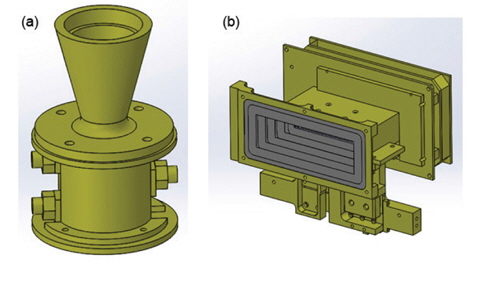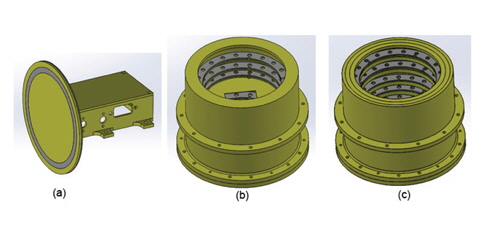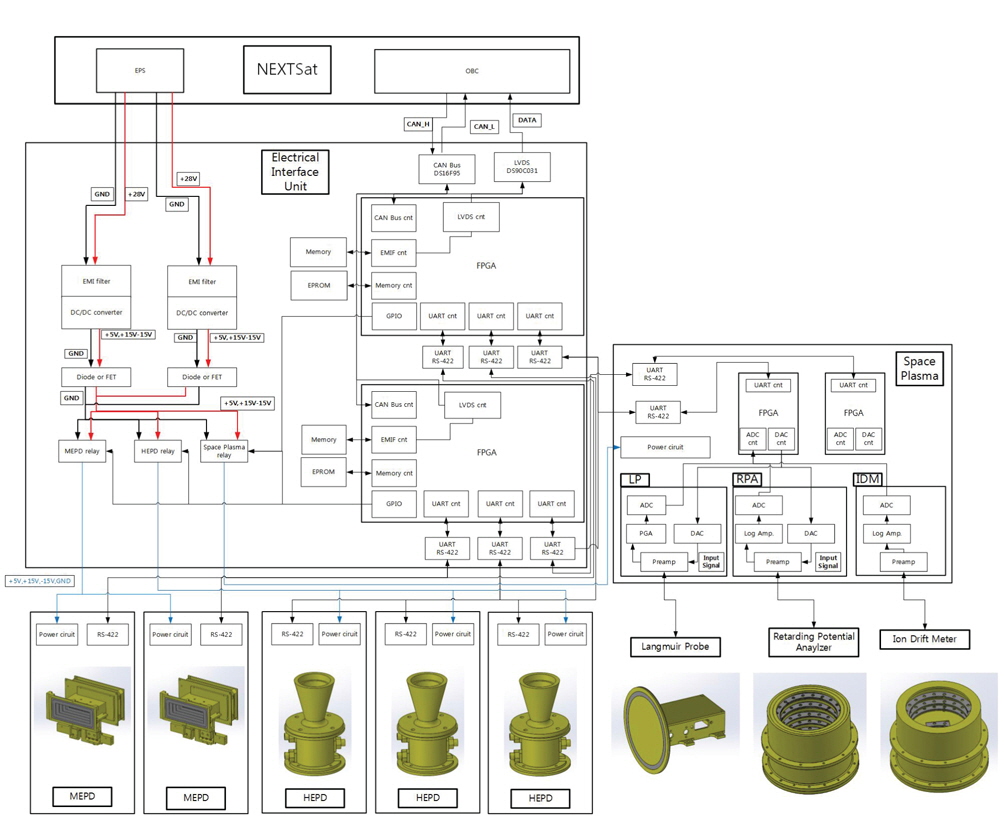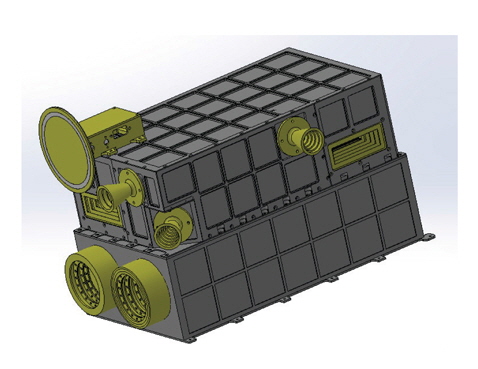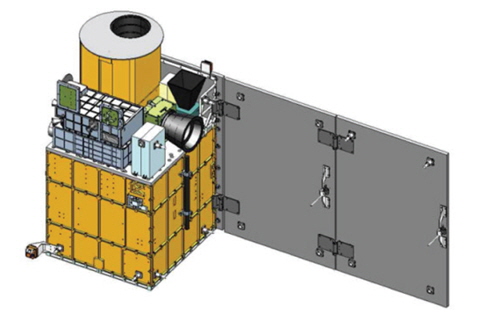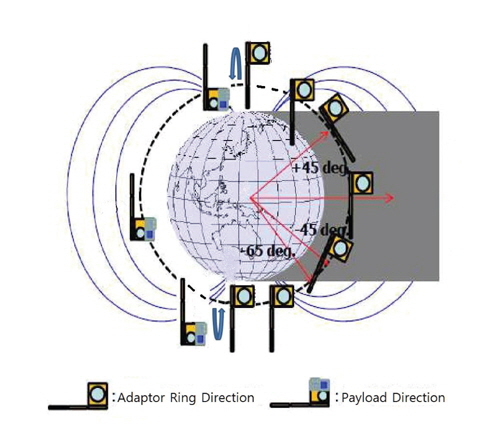



Space storms are caused by abrupt changes in solar activity such as coronal mass ejections (CMEs), which are known to occur during solar maximums, while less severe space storms that result from high speed solar winds generated by the co-rotating interaction region (CIR) passing through the magnetosphere occur during the declining phase of the solar cycle. This type of space storm in the declining phase of the solar cycle occurs periodically with the rotation of the sun and it has a larger impact on the radiation belt than the less frequent but more severe space storms during solar maximums.
The Korean government has planned the development of the Next Generation Small Satellite (NEXTSat) since 2012 in order to develop a standardized satellite bus after a series of small satellites were developed (three units in the KITSAT series and three units in the Science and Technology Satellite (STSAT) series). The first satellite is NEXTSat-1, which is scheduled for launch in May 2016. Significant results are expected because its launch coincides with the declining phase of the solar cycle. Furthermore, together with the Energization and Radiation Geospace (ERG), which will be launched in 2015 to observe the radiation belt in an elliptical orbit of the equatorial plane, the radiation particles in the polar orbit will be observed and this could provide a significant opportunity for collaborative efforts to investigate the process of radiation particle acceleration and the annihilation of the particles that penetrate the polar atmosphere. From this perspective, the ISSS, which is developed in order to measure space storms in low altitude polar orbits, is a significant payload (Sohn et al. 2012). Besides the ISSS, NEXTSat-1 is also equipped with a test apparatus for space technology experiments and NISS to study star forming regions through infrared spectroscopic imaging.
Space storms are defined as the abrupt reduction of geomagnetic fields measured in the equatorial region as a result of the increase in the ring current around Earth. Space storms accompany abrupt increases in radiation belt particles, increases in auroras occurring due to the increase in the charged particles that interact with Earth’s atmosphere from the magnetosphere, abrupt changes in the ionosphere through the effect of the electric field penetration from the magnetosphere, and changes in the circulation of neutral winds as a result of the polar thermosphere heating and density variations in the ionosphere. While the root cause of space storms are based on changes in solar activity, a variety of space storm events are generated from the complex and various nonlinear cause-and-effect relationships in Earth’s magnetosphere and ionosphere. The mission of the ISSS is to observe space storms that occur in dynamic and versatile forms in the radiation belt and ionosphere near Earth’s space.
After discovery by Explorer-1 in 1958, the Earth’s radiation belt has consistently been the focus of research from two perspectives: the foundational science perspective that investigates the generation and annihilation of radiation particles and the engineering perspective that investigates the impact of these particles on human space activities such as satellites. In particular, the study of the so-called killer electron with an energy range of approximately 100 keV, which is considered a prime cause of satellite failure, has become a focus as the degree of electronic component integration in satellites increases and the satellite performance is enhanced. Therefore, observation of the radiation particles related to space storms is a focus of foundational science associated with the particle acceleration mechanisms and it is also the basis of engineering models for human activities in space.
An event caused by space storms is abrupt changes in the ionosphere. In particular, variations in the ionosphere are difficult to predict because they are closely related to the movement of the atmosphere. For example, although ionosphere storms can be predicted using explosions in the sun, it is difficult to predict the ionosphere variation time and whether the electron density increases or decreases in a specific region. The ionosphere variation affects GPS signals, which are used in daily life; in particular, ionosphere irregularities induce scintillation in GPS signals resulting in rapid degradation of the signal quality. Therefore, observing space storms that occur in the ionosphere would assist with establishing the basis of engineering applications related to everyday life as well as supporting scientific investigations of the plasma instability that causes ionosphere irregularities.
NEXTSat-1 is scheduled for launch in May 2016 for a mission to observe space storms during the declining phase of the solar cycle. The scientific mission and operation of the ISSS equipment, which will be preloaded on NEXTSat-1, are described in this paper.
2.1 ISSS space radiation measurement mission
Current theory states that the significant causes of particle acceleration in the radiation belt are shock from solar winds (Li et al. 1997), radial diffusion via ultra-low frequency (ULF) waves (Elkington et al. 2003), and resonant acceleration from wave-particle interactions (Summers et al. 1998). Furthermore, it is known that accelerated radiation particles are annihilated when mixed with solar winds after streaming out from the magnetopause or when the particles captured in the equatorial plane collide with the atmosphere after precipitation into the polar region following the magnetic line of force through wave-particle interactions. In particular, interactions between magnetosphere particles and plasma waves have a significant impact on the generation and annihilation of high-energy particles. The plasma waves are whistler mode choruses and electromagnetic ion cyclotrons (EMICs). Whistler waves impact the generation and annihilation of electrons in the broadband energy spectrum and EMIC waves impact the annihilation of high-energy electrons.
However, there have been contradictory observations on the annihilation of high-energy electrons that are precipitated in the polar region. While the electron microburst that occurs at approximately 1 MeV with a time scale of 100 msec on the dawn-side of local time has been reported using satellite observations, the annihilation of high-energy (a few MeV) electrons with longer time scales of a few minutes to a few hours, which are known as duskside relativistic electron precipitations (DREPs), has been reported using balloon observations on the night side (Millan et al. 2002). Dozens of keV electron microbursts have been observed using rockets in the 1960s (Lampton 1967), and 100 keV electron microbursts were observed by STSAT-1 in the 2000s (Lee et al. 2005). Furthermore, MeV electron microbursts were observed by SAMPX (Lorentzen et al. 2001); therefore, microbursts occur in broad energy spectra. Because the observation region is consistent with the dawn-side where whistler waves are prone, the relevant plasma wave is considered to be a whistler wave. In contrast, the DREP observation region is consistent with the EMIC observation region and is also related to the plume observation region of the plasma layer. Moreover, while microbursts predominantly occur when magnetic storms are observed, DREPs are known to occur frequently even when it is magnetically quiet.
The purpose of the space radiation measurements onboard the NEXTSat-1, which is a low altitude polar orbit satellite, is to understand the mechanism of particle acceleration and annihilation through measuring highenergy particle fluxes during magnetic storms result from solar events. These microburst and DREP events are typical phenomena of upper atmosphere collisions, which are one method of particle annihilation in the radiation belt. Therefore, the study of space radiation storms using ISSS focuses on microburst and DREP events, as well as researching answers to the following questions:
i. Are microbursts generated simultaneously at low energy and high energy? ii. What is the difference between the energy spectrum of microbursts and that of trapped electrons? iii. How quickly does the pitch angle scattering related to microburst occur? It is known that the pitch angle scattering resulting from chorus waves is progressive. Is the particle annihilated into the atmosphere through the microburst in the periphery of the loss cone? iv. In which region of Earth’s magnetic field does pitch angle scattering occur? v. What type of change does the seed electron experience? vi. Do DREP events only occur in high-energy particles as reported in previous observations?
It is necessary to obtain the electron spectrum with a range of dozens of keV to 1 Mev in the sub-auroral region as well as the pitch angle information in order to achieve these mission goals.
2.2 ISSS plasma measurement mission
Various forms of plasma irregularity exist in the low latitude region. The Equatorial Plasma Bubble (EPB), which has a lower temperature and density than its surroundings, is a well-known irregularity. It occurs at lower altitudes than the observation region of the EPB. Meanwhile, bubbles with lower densities and higher temperatures are observed occasionally, even plasma blobs with higher densities than their surroundings can be observed. These types of various irregularities will be measured by ISSS because it will make observations at mid and low latitudes, and observation of these small-scale irregularities is the primary goal. Because the time resolution of conventional ionosphere measurement instruments is only 4 sec for the Defense Meteorological Satellite Program (DMSP) and 1 sec for ROCSAT-1, they are not appropriate for studying smallscale irregularities. Therefore, small-scale irregularities have been studied using the magnetic field measurement data with better time resolutions (Xiong et al. 2011). The scintillation that results from the ionosphere irregularities has a severe impact on GPS signals. If the distance between the irregularities and GPS receiving station is 1000 km, the Fresnel length of a GPS L-1 signal with a wavelength of 19 cm would be 150 m. Therefore, in order to compare the ionosphere irregularities and GPS signal scintillations, a 50 Hz sampling rate is required for a satellite speed of 7.8 km/sec.
Based on these issues, the space plasma observations of ISSS will focus on the following questions:
i. How does the density, temperature, and ion component in the upper ionosphere vary during the phase between the quiet time and disturbed time? What is the difference between the conventional ionospheric reference ionosphere (IRI) model and the observation results? ii. Compared with the DMSP and ROCSAT-1 data measured at different altitudes, what are the variations in the density, temperature, and ion component measured by the NEXTSat-1 as a function of altitude? iii. How does the drift motion of the ionosphere change with altitude? When the altitude of NEXTSat-1 is between 600 km and 840 km, what ionosphere drift motion exists between these two measured data? iv. How does the distribution change according to the scale of plasma irregularities in the EPB? Are there dependencies on the season and longitude? Are there differences between the quiet time and disturbed time? v. Are there correlations between the scale size of the plasma irregularities and drift motion of the ionosphere? vi. Are there correlations between the scale size of the plasma irregularities and GPS scintillations?
In order to achieve these goals, the space plasma payload of ISSS consists of LP, RPA, and IDM, and the observations will be conducted at mid and low latitudes between +45° and –45°. In particular, the LP will have a sampling rate of 50 Hz for comparison with the scattering effect of the GPS signal, because data reduction is possible through calculations of electron density with onboard processing.
2.3 Additional scientific missions
The precipitation of radiation particles into Earth’s atmosphere and the variations in the ionosphere density and temperature also occur in special cases other than space storms. The ISSS instruments will also observe these unusual events. Because catastrophes occur on Earth’s surface such as volcanoes, earthquakes, and tsunamis, and these are propagated into the upper atmosphere and affect the ionosphere, the effects of these catastrophes on Earth on the ionosphere can be analyzed using the ionosphere measurement data. In particular, it is considered that small changes in the ionosphere are detected as precursors to Earth’s catastrophes, but this correlation is not sufficiently clear for use in forecasting. However, it could be worthwhile to investigate these phenomena in an attempt to improve future forecasts (Le et al. 2011). In some cases, the VLF produced by lightening, earthquakes, and occasionally artificial reasons causes high-energy particles to penetrate into the atmosphere, which is understood through the VLF causing the pitch angle scattering of high-energy particles into the loss cone through wave-particle interactions. The ISSS observation instruments for space radiation and space plasma could also measure these unusual events.
If a solar proton event occurs, which is not predicted during the solar declining phase, the impact could also be observed using the ISSS. For example, if a solar proton event occurs, investigating whether protons penetrate into the magnetosphere and affect the inner radiation belt or whether they only impact the slot region would be interesting. Furthermore, when an event occurs, it could become important if protons in the magnetosphere have an isotropic pitch angle distribution and if there is an annihilation process in the increased protons in the solar origin.
In order to observe space radiation, electrons with energies of dozens of keV to 1 MeV and protons with higher energies must be detected. The low orbit proton flux and electron flux observations from satellites to date are described below. For an energy of 10 keV, the proton flux in the polar regions is ~105 (cm2 s sr keV)-1; the polar region electron flux is ~108 (cm2 s sr keV)-1; the energetic neutral atom (ENA) flux is ~104 (cm2 s sr keV)-1; the electron flux with an energy of 100 keV to 1 MeV is approximately ~102 to ~107 (cm2 s sr keV)-1 according to various satellite measurements (Science Technology Satellite-1, NASA AE8 (USA), and NOAA POES). For solar protons, the energy of high-energy particles from the solar origin is approximately 10~1000 MeV and the flux is approximately 1 ~ 106 (cm2 s)-1 according to Schimmerling & Curtis (1978).
The ISSS space radiation instruments consist of two instruments as depicted in Figs. 1a and 1b. Each instrument has two sets of telescopes for MEPD and three sets of telescopes for HEPD, and each observes in parallel and vertical directions (HEPD also observes inside angles) in relation to Earth’s magnetic field in the sub-auroral region. The technical requirements determined based on past measurements are presented in Table 1. For the MEPD, because the predicted flux in the low energy band is very high, an attenuator is used to reduce the number of particles in the detector.
[Table 1.] MEPD and HEPD technical requirements.
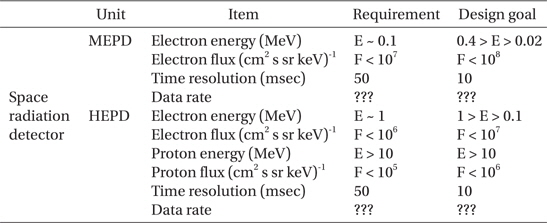
MEPD and HEPD technical requirements.
The ISSS space plasma detectors consist of a LP, RPA, and IDM as presented in Figs. 2a-c, respectively; these detectors observe at mid and low latitude regions. Because the ionosphere is electrically neutral in a relative sense, the electron density and ion densities of oxygen, hydrogen, and helium are generally considered to be equal. Therefore, the accuracy of the instruments can be deduced through comparing the electron density from the LP and the ion density from the RPA.
The density and temperature changes in the electrons and ions during ionosphere storms based on the past measurements are described below. The daytime observations demonstrate that the maximum electron (or ion) density at an altitude of 600 km is 2×106 cm-3 for positive storms and 3×105 cm-3 of DMSP at an altitude of 840 km. According to the nighttime observation results, the electron (or ion) density dropout measured during the nighttime in the ionosphere when the DST value reached –320 nT in April 2000 was 104 cm-3 measured by ROCSAT-1 at an altitude of 600 km (Su et al. 2002). Meanwhile, it was observed that an ion drift motion existed between +500 m/ sec and –200 m/sec at the time. According to the observation results at an altitude of 840 km (Kil et al. 2011) during a magnetic storm with a DST value of -400 nT in March 2003, the ion density of the positive storm was less than 106 cm-3 and the magnitude of the density dropout in the negative storm was less than 104 cm-3. The ion drift motion observed at the time was less than 1 km/sec in the low altitude region. Based on these observations, the electron (or ion) density is generally considered to be within the range of a maximum of 2×106 cm-3 during the positive storm during daytime and a minimum of 104 cm-3 in a negative storm during nighttime. Moreover, the range of ion drift motion is assumed to be less than 1 km/sec. According to the measurements reported by Rao & Yeh (1968) during an ionosphere storm in the mid-latitude region at an altitude of 400 km, the temperature of the electrons and ions had a maximum of 3000 K during daytime and a minimum of 600 K during nighttime. Furthermore, according to the analyses reported by Kil et al. (2003) during an ionosphere storm in July 2000, the temperature changes of the ions in the mid and low latitude regions at an altitude of 840 km were between 1000 K and 3000 K. Based on these observations, the electron temperature range is considered to be between 600 K and 3000 K for low latitude observations and the ion temperature range is between 1000 K and 3000 K. Based on these past measurement data, the technical requirements for the space plasma detector are presented in Table 2.
[Table 2.] LP, RPA, and IDM technical requirements.
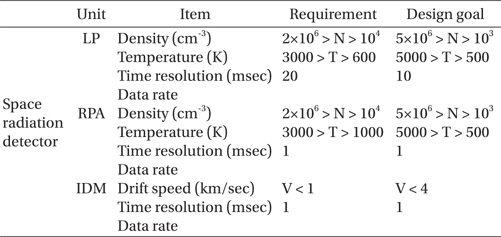
LP, RPA, and IDM technical requirements.
The total weight of the ISSS is approximately 16 kg, and its daily power consumption is approximately 8.75 W. Furthermore, the daily data production is estimated to be 1.38 Gbits. The ISSS system block diagram is presented in Fig. 3. The operation and communications of the space plasma detectors (LP, RPA, IDM), HEPD, and MEPD are implemented using field programmable gate arrays (FPGAs). All FPGAs are connected to the satellite through electrical interface units (EIUs). The EIUs provide interfaces for the power supply and communication systems. The EIUs divide the 28 V power signal received from the satellite into +5 V, +15 V, and –15 V in order to feed to the instruments and to transmit the operation commands received through controller area network (CAN) to specific instruments in order to conduct the observations. The data generated during the observations are transmitted to the EIUs, saved in the internal memory system, and sent to the satellite through low voltage differential signal (LVDS) communication links in response to data transfer requests.
The overall configuration of the ISSS mechanical structure is presented in Fig. 4 including the subcomponents described in Figs. 1 and 2. The space plasma detector of the RPA and IDM, backplane connector, and EIU section are located in the lower part of the ISSS structure. The space radiation detector of the MEPD and HEPD, and the preamp section of the LP are located in the upper part of the ISSS structure. In order to obtain the physical quantities to investigate space storms, the detector directions of the LP, RPA, and IDM are in parallel with the satellite’s flight direction. The MEPD detector position is in parallel with and vertical to the direction of Earth’s magnetic field. Furthermore, in order to better identify the type of wave affecting the acceleration and scattering of radiation particles, the detector direction is set to enable measurements parallel and vertical to Earth’s magnetic field direction and at angles between these.
The NEXTSat-1 consists of six core space technology payloads and two science mission payloads. The core space technology payloads consist of a science data storage module (SDR-10), a three-dimensional mass memory module (3DMMM), an S-band digital transponder (SDT) for the satellite, an onboard computer (OBC) for the satellite, a space-class fiber optic gyro (FOG), and an FMclass high precision star tracker (STR). The science mission payloads consist of a near-infrared imaging spectrometer for star formation history (NISS) and instruments for the study of space storms (ISSS). Fig. 5 presents the complete picture of the satellite with all payloads. In Fig. 5, the space core technology of SDR-10 and OBC are located counterclockwise from the ISSS located at the lower left; behind them, the STR baffle is placed in the direction of the solar panel. The NISS optics are located in the upward direction behind the STR.
The ISSS will operate depending on the characteristics of the space radiation detector and space plasma detector. During the timeslot from noon to midnight, the ISSS will operate in the sun-synchronous orbit or orbits of similar characteristics at an altitude of 600 ~ 800 km. The observations will be performed for seven days in an independent orbit right after the occurrence of a solar event such as a solar flare or coronal mass ejections. The ISSS will operate the space radiation detector in the polar region at a latitude of 90 ~ 45° south at nighttime and the satellite attitude is controlled in order that the two telescopes in the MEPD and HEPD are parallel or vertical to Earth’s magnetic field, as described in Fig. 6. Furthermore, the satellite attitude must be altered in the polar region at nighttime at the southern latitude of 90° in order to operate the space radiation detector. The satellite attitude must be controlled by rotating it 180° from the solar panel as a reference. In the polar region with a north latitude of 45 ~ 90°, the space radiation detector operates using the internal power from the satellite regardless of the attitude control in Fig.6. At the equator region with a latitude of -45° ~ +45°, the space plasma detector operates at nighttime. The satellite attitude is controlled in order that the RPA and IDM are in the satellite flight direction (ram direction). The LP is also positioned to be in the flight direction. The space plasma detector should not be affected by the wake of the satellite and should be located on the outer side of the satellite where the solar panel has no effect.
The ISSS are proposed as a payload for the Next Generation Small Satellite-1 (NEXTSat-1), which is scheduled for launch in May 2016. The ISSS and their missions have been described in this paper. The ISSS for the NEXTSat-1 consists of a space radiation detector and a space plasma detector. The space radiation detector consists of a MEPD and HEPD, and the space plasma detector consists of a LP, RPA, and IDM.
The primary mission of NEXTSat-1 is technology experiments and the six instruments are equipped for this goal. The daytime operations of the satellite are primarily allocated for the technology experiments; however, scientific observations are only available during the nighttime operation. Furthermore, the astronomical observations of the infrared spectroscopic images and space observations should share this timeslot. In particular, the nighttime observations impose severe constraints on the operation of the two instruments from the perspective of power consumption and attitude control. Therefore, the ISSS operation will be an event-driven process unlike the continuous operations of other space observation satellites, and the operation will be limited to the expected times of space storms. That is, the observations will only be performed during solar explosions, CME occurrences, and expected times when CIRs pass through the magnetosphere. For these operations, continuous solar observations are essential; premeditated and efficient operation scenarios must be established prior to launch in order to enable the immediate operation of ISSS when a solar event occurs. It is planned to accumulate quiet time data in the early stages of the satellite operation. Furthermore, observations during the spring equinox and autumn equinox during which solar storms are prone to occur should be performed together with observations during the summer solstice and winter solstice for comparison.
It is known that solar radiation storms occur frequently during the declining phase of the solar cycle compared with the solar maximum. The NEXTSat-1 is scheduled for launch in May 2016; this is prior to the declining phase of solar cycle 24 and it is a significant opportunity to observe space radiation storms. If this opportunity is missed, the next observation can be made after 11 years in 2027. In particular, while full-scale radiation belt missions such as RBSP, ERG, and THEMIS, are scheduled at the equatorial plane during this period, there is no mission for observing the radiation particles with a polar orbit satellite. Therefore, if this mission to observe the radiation particles using a polar orbit satellite is completed successfully, it would be possible to collaboratively analyze with other satellites at the equatorial plane, and significant scientific achievements could be expected. Furthermore, if international scientists use the measurement data from the Korean satellite, it could increase the scientific status of Korea in the area of space science. Moreover, collaborative analyses using the data from the space meteorological payload of the meteorological satellite on the geostationary multi-purpose satellite, which is scheduled for launch in 2017, would be expected to enhance the efficiencies of both satellite data.
